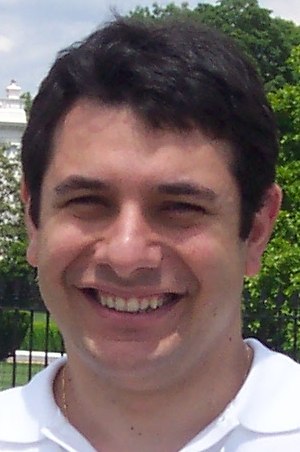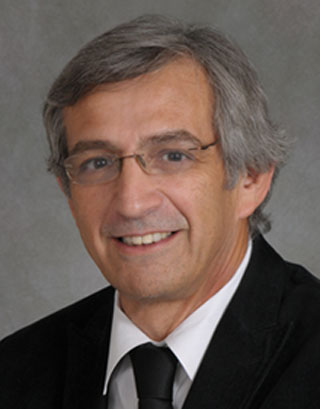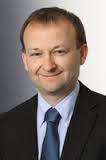Difference between revisions of "Events"
(→Professor Marek Behr) |
(→Visitors) |
||
| Line 1: | Line 1: | ||
= Visitors = | = Visitors = | ||
| − | + | == Professor Dimitrios S. Nikolopoulos == | |
School of Electronics, Electrical Engineering and Computer Science | School of Electronics, Electrical Engineering and Computer Science | ||
| Line 22: | Line 22: | ||
'''Bio''': Dimitrios S. Nikolopoulos is Professor in the School of EEECS, at Queen's University of Belfast and a Royal Society Wolfson Research Fellow. He holds the Chair in High Performance and Distributed Computing and directs the HPDC Research Cluster, a team of 20 academic and research staff. His research explores scalable computing systems for data-driven applications and new computing paradigms at the limits of performance, power and reliability. Dimitrios received the NSF CAREER Award, the DOE CAREER Award, and the IBM Faculty Award during an eight-year tenure in the United States. He has also been awarded the SFI-DEL Investigator Award, a Marie Curie Fellowship, a HiPEAC Fellowship, and seven Best Paper Awards including some from the leading IEEE and ACM conferences in HPC, such as SC, PPoPP, and IPDPS. His research has produced over 150 top-tier outputs and has received extensive (£10.6m as PI/£39.5m as CoI) and highly competitive research funding from the NSF, DOE, EPSRC, SFI, DEL, Royal Academy of Engineering, Royal Society, European Commission and private sector. Dimitrios is a Fellow of the British Computer Society, Senior Member of the IEEE and Senior Member of the ACM. He earned a PhD (2000) in Computer Engineering and Informatics from the University of Patras. </li> | '''Bio''': Dimitrios S. Nikolopoulos is Professor in the School of EEECS, at Queen's University of Belfast and a Royal Society Wolfson Research Fellow. He holds the Chair in High Performance and Distributed Computing and directs the HPDC Research Cluster, a team of 20 academic and research staff. His research explores scalable computing systems for data-driven applications and new computing paradigms at the limits of performance, power and reliability. Dimitrios received the NSF CAREER Award, the DOE CAREER Award, and the IBM Faculty Award during an eight-year tenure in the United States. He has also been awarded the SFI-DEL Investigator Award, a Marie Curie Fellowship, a HiPEAC Fellowship, and seven Best Paper Awards including some from the leading IEEE and ACM conferences in HPC, such as SC, PPoPP, and IPDPS. His research has produced over 150 top-tier outputs and has received extensive (£10.6m as PI/£39.5m as CoI) and highly competitive research funding from the NSF, DOE, EPSRC, SFI, DEL, Royal Academy of Engineering, Royal Society, European Commission and private sector. Dimitrios is a Fellow of the British Computer Society, Senior Member of the IEEE and Senior Member of the ACM. He earned a PhD (2000) in Computer Engineering and Informatics from the University of Patras. </li> | ||
| − | + | == Professor Lieber, Baruch Barry == | |
Department of Neurosurgery | Department of Neurosurgery | ||
| Line 44: | Line 44: | ||
'''Bio:''' Barry Lieber attended Tel-Aviv University and received a B.Sc. in Mechanical Engineering in 1979. He then attended Georgia Tech and received M.Sc. in 1982 and a Ph.D. in 1985, both in Aerospace Engineering Ph.D. working with Dr. Don P. Giddens. Barry Lieber was a Postdoctoral Fellow from 1985-1987 at the Department of Mechanical Engineering at Georgia Tech and also completed a summer fellowship at Imperial College London in 1986. In 1987 Barry Lieber joined the faculty of the Department of Mechanical and Aerospace Engineering at the State University of New York at Buffalo as Assistant Professor. In 1993 he was promoted to the rank of Associate Professor with tenure and in 1998 was promoted to full professor. In 1994 he became Research Professor of Neurosurgery and in 1997 he became the Director of the Center for Bioengineering at the State University of New York at Buffalo, both position he held until his departure from the university in 2001 to Join the University of Miami as professor in the Department of Biomedical Engineering with a joined appointment in the Department of Radiology. In 2010 he joined the State University of New York at Stony Brook at the rank of professor in the department of Neurosurgery and also serves as program faculty in the department of Biomedical Engineering. Barry Lieber was elected as fellow of the American Institute for Medical and Biomedical Engineering in 1999. He was elected as fellow of the American Society of mechanical Engineers in 2005 and served as the Chairman of the Division of Bioengineering of the American Society of Mechanical Engineers in 2009. </li> | '''Bio:''' Barry Lieber attended Tel-Aviv University and received a B.Sc. in Mechanical Engineering in 1979. He then attended Georgia Tech and received M.Sc. in 1982 and a Ph.D. in 1985, both in Aerospace Engineering Ph.D. working with Dr. Don P. Giddens. Barry Lieber was a Postdoctoral Fellow from 1985-1987 at the Department of Mechanical Engineering at Georgia Tech and also completed a summer fellowship at Imperial College London in 1986. In 1987 Barry Lieber joined the faculty of the Department of Mechanical and Aerospace Engineering at the State University of New York at Buffalo as Assistant Professor. In 1993 he was promoted to the rank of Associate Professor with tenure and in 1998 was promoted to full professor. In 1994 he became Research Professor of Neurosurgery and in 1997 he became the Director of the Center for Bioengineering at the State University of New York at Buffalo, both position he held until his departure from the university in 2001 to Join the University of Miami as professor in the Department of Biomedical Engineering with a joined appointment in the Department of Radiology. In 2010 he joined the State University of New York at Stony Brook at the rank of professor in the department of Neurosurgery and also serves as program faculty in the department of Biomedical Engineering. Barry Lieber was elected as fellow of the American Institute for Medical and Biomedical Engineering in 1999. He was elected as fellow of the American Society of mechanical Engineers in 2005 and served as the Chairman of the Division of Bioengineering of the American Society of Mechanical Engineers in 2009. </li> | ||
| − | + | == Professor Marek Behr == | |
Chair for Computational Analysis of Technical | Chair for Computational Analysis of Technical | ||
| Line 82: | Line 82: | ||
'''Bio:''' Prof. Marek Behr obtained his Bachelor's and Ph.D. degrees in Aerospace Engineering and Mechanics form the University of Minnesota in Minneapolis. After faculty appointments at the University of Minnesota and at Rice University in Houston, he was appointed in 2004 as a Professor of Mechanical Engineering and holder of the Chair for Computational Analysis of Technical Systems at the RWTH Aachen University. Since 2006, he is the Scientific Director of the Aachen Institute for Advanced Study in Computational Engineering Science, focusing on inverse problems in engineering and funded in the framework of the Excellence Initiative in Germany. Behr advises or has advised over 40 doctoral students, and has published over 65 refereed journal articles and a similar number of conference publications and book chapters. Behr is one of the main developers of the stabilized space-time finite element formulation for deforming-domain flow problems, which has been recently extended to unstructured space-time meshes. He is a long-time expert on parallel computation and large-scale flow simulations and on numerical methods for non-Newtonian fluids. He is a member of several advisory and editorial boards of international journals, and the member of the executive council of the German Association for Computational Mechanics and of the general council of the International Association for Computational Mechanics. </li> | '''Bio:''' Prof. Marek Behr obtained his Bachelor's and Ph.D. degrees in Aerospace Engineering and Mechanics form the University of Minnesota in Minneapolis. After faculty appointments at the University of Minnesota and at Rice University in Houston, he was appointed in 2004 as a Professor of Mechanical Engineering and holder of the Chair for Computational Analysis of Technical Systems at the RWTH Aachen University. Since 2006, he is the Scientific Director of the Aachen Institute for Advanced Study in Computational Engineering Science, focusing on inverse problems in engineering and funded in the framework of the Excellence Initiative in Germany. Behr advises or has advised over 40 doctoral students, and has published over 65 refereed journal articles and a similar number of conference publications and book chapters. Behr is one of the main developers of the stabilized space-time finite element formulation for deforming-domain flow problems, which has been recently extended to unstructured space-time meshes. He is a long-time expert on parallel computation and large-scale flow simulations and on numerical methods for non-Newtonian fluids. He is a member of several advisory and editorial boards of international journals, and the member of the executive council of the German Association for Computational Mechanics and of the general council of the International Association for Computational Mechanics. </li> | ||
| − | + | == Professor Christos Antonopoulos == | |
| − | + | == Professor Yongjie Jessica Zhang == | |
| − | + | == Professor David Marcum == | |
| − | + | == Professor Kyle Gallivan == | |
| + | |||
| + | == Professor Suzanne M. Shontz == | ||
| − | |||
= Workshops = | = Workshops = | ||
= Outreach = | = Outreach = | ||
Revision as of 11:50, 26 March 2018
Contents
Visitors
Professor Dimitrios S. Nikolopoulos
School of Electronics, Electrical Engineering and Computer Science
Queen's University of Belfast, UK
When:Nov 12,2015, 10:30AM
Where:E & CS Auditorium, First Floor
What:New Approaches to Energy-Efficient and Resilient HPC
Email:d.nikolopoulos@qub.ac.uk
Homepage: http://www.cs.qub.ac.uk/~D.Nikolopoulos/
ABSTRACT
This talk explores new and unconventional directions towards improving the energy-efficiency of HPC systems. Taking a workload-driven approach, we explore micro-servers with programmable accelerators; non-volatile main memory; workload auto-scaling and structured approximate computing. Our research in these has achieved significant gains in energy-efficiency while meeting application-specific QoS targets. The talk also reflects on a number of UK and European efforts to create a new energy-efficient and disaggregated ICT ecosystem for data analytics.
Professor Lieber, Baruch Barry
Department of Neurosurgery
Stony Brook University
When:Nov. 6, 2015, 10:30AM
Where: E & CS Auditorium, First Floor
What:Flow Diverters to Cure Cerebral Aneurysms a Case Study - From Concept to Clinical
Email: Baruch.Lieber@stonybrookmedicine.edu
Homepage:http://neuro.stonybrookmedicine.edu/about/faculty/lieber
ABSTRACT
Ten to fifteen million Americans are estimated to harbor intracranial aneurysms (abnormal bulges of blood vessels located in the brain) that can rupture and expel blood directly into the brain space outside of the arteries causing a stroke. A flow diverter, a refined tubular mesh-like device that is inserted through a small incision in the groin area (no need for open brain surgery) and navigated through a catheter into cerebral arteries to treat brain aneurysms is delivered into the artery carrying the aneurysm. The permeability of the device is optimized such that it significantly reduces the blood flow in the aneurysm, while keeping small side branches of the artery open to supply critical brain tissue. The biocompatible device elicits a healthy scar-response from the body that lines the inner metal surface of the device with biological tissue, thus restoring the diseased arterial segment to its normal state. Refinement in the design of such devices and prediction of their long term creative effect, which usually occurs over a period of months can be significantly helped by computer modeling and simulations of the flow alteration such devices impart to the aneurysm. The evolution of these devices will be discussed from conception to their current clinical use.
Professor Marek Behr
Chair for Computational Analysis of Technical
RWTH Aachen University
Systems, Schinkelstr. 2, 52062 Aachen, Germany
When:July 31, 2015, 10:30AM
Where: E & CS Auditorium, First Floor
What:Enhanced Surface Definition in Moving-Boundary Flow Simulation
Email: behr@cats.rwth-aachen.de
Homepage:http://www.cats.rwth-aachen.de
ABSTRACT
Moving-boundary flow simulations are an important design and analysis tool in many areas of engineering, including civil and biomedical engineering, as well as production engineering [1]. While interface-capturing offers unmatched flexibility for complex free-surface motion, the interface-tracking approach is very attractive due to its better mass conservation properties at low resolution. We focus on interface-tracking moving-boundary flow simulations based on stabilized discretizations of Navier-Stokes equations, space-time formulations on moving grids, and mesh update mechanisms based on elasticity. However, we also develop techniques that promise to increase the fidelity of the interface-capturing methods.
In order to obtain accurate and smooth shape description of the free surface, as well as accurate flow approximation on coarse meshes, the approach of NURBS-enhanced finite elements (NEFEM) [2] is being applied to various aspects of free-surface flow computations. In NEFEM, certain parts of the boundary of the computational domain are represented using non-uniform rational B-splines (NURBS), therefore making it an effective technique to accurately treat curved boundaries, not only in terms of geometry representation, but also in terms of solution accuracy.
As a step in the direction of NEFEM, the benefits of a purely geometrical NURBS representation of the free-surface could already be shown [3]. The first results with a full NEFEM approach for the flow variables in the vicinity of the moving free surface have also been obtained. The applications include both production engineering, i.e., die swell in plastics processing simulation, and safety engineering, i.e., sloshing phenomena in fluid tanks subjected to external excitation.
Space-time approaches offer some not-yet-fully-exploited advantages when compared to standard discretizations (finite-difference in time and finite-element in space, using either method of Rothe or method of lines); among them, the potential to allow some degree of unstructured space-time meshing. A method for generating simplex space-time meshes is presented, allowing arbitrary temporal refinement in selected portions of space-time slabs. The method increases the flexibility of space-time discretizations, even in the absence of dedicated space-time mesh generation tools. The resulting tetrahedral (for 2D problems) and pentatope (for 3D problems) meshes are tested in the context of advection-diffusion equation, and are shown to provide reasonable solutions, while enabling varying time refinement in portions of the domain [4].
[1] S. Elgeti, M. Probst, C. Windeck, M. Behr, W. Michaeli, and C. Hopmann, "Numerical shape optimization as an approach to extrusion die design", Finite Elements in Analysis and Design, 61, 35–43 (2012).
[2] R. Sevilla, S. Fernandez-Mendez and A. Huerta, "NURBS-Enhanced Finite Element Method (NEFEM)", International Journal for Numerical Methods in Engineering, 76, 56–83 (2008).
[3] S. Elgeti, H. Sauerland, L. Pauli, and M. Behr, "On the Usage of NURBS as Interface Representation in Free-Surface Flows", International Journal for Numerical Methods in Fluids, 69, 73–87 (2012).
[4] M. Behr, "Simplex Space-Time Meshes in Finite Element Simulations", International Journal for Numerical Methods in Fluids, 57, 1421–1434, (2008).


